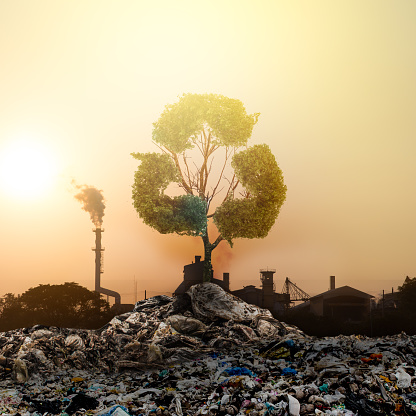
In the face of the impending “Global Waste Crisis,” Waste Management is no longer just a buzzword.
According to World Bank figures, approximately 1.3 billion tonnes of waste is generated each year, with volumes expected to rise to 2.2 billion tonnes by 2025. So, it is time to act!

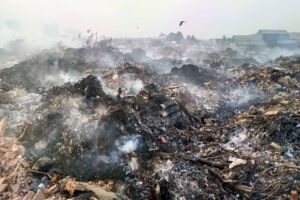
I understand that this isn’t everyone’s favourite topic to discuss, and it’s not my intention to send you on a guilt trip. We are, however, responsible for the predictable consequences of our actions!
The year 2018 marked a watershed moment in my life when I met two ladies by chance who also share a commitment to social causes and a willingness to dream big. They are now close friends of mine. Our meetings always end with a discussion of what we should do next, and we discussed “Solid Waste Management” in our community during the first meeting. An initiative in which residents can drive change through individual actions.
Our specific goal is “Zero Waste to Landfill,” which establishes a baseline in the waste hierarchy.
Does the term ‘Zero Waste’ literally mean no waste is disposed of in a landfill? The standard interpretation is that at least 99 percent of waste generated is diverted away from landfills, implying that all waste produced is reused, recycled, composted, or sent to energy recovery (incineration). However, even with the most efficient waste management systems, some materials must be disposed of in landfills due to the lack of alternative waste treatment methods.
Until a few years ago, from 2012 to early 2018, the community used green (wet kitchen waste) and red biodegradable plastic bags (everything else, including sanitary) in the mistaken belief that we diligently segregated our waste. But, unfortunately, we didn’t give the plastic bags a second thought! The organic waste was the only waste sent to our community’s Organic Waste Converter for composting and use as manure for our landscaping. The red bags were collected by a Vendor, whom we assumed would segregate and dispose of them responsibly, but most of the time, they ended up in a landfill or dumped alongside waterfronts or on vacant lands.
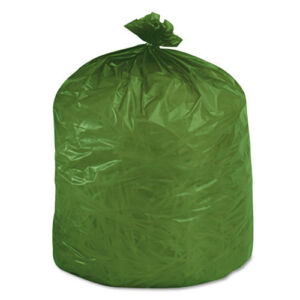
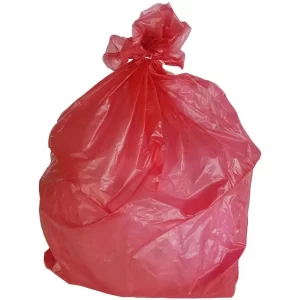
What became of those green and red plastic bags? We now understand that a plastic bag’s ‘end of life’ option is “Recycling and Waste-to-Energy (incineration).”
Our beautiful township was subjected to illegal garbage dumping and burning along our backwaters during this time. Thanks to the efforts of a dedicated group of residents, the miscreants were eventually kept at bay. Nonetheless, because of these man-made garbage mountains burning and churning toxicity in their underbelly, our community was engulfed in thick smog, the unbearable stench of the decomposing waste, significant health risks, and more.
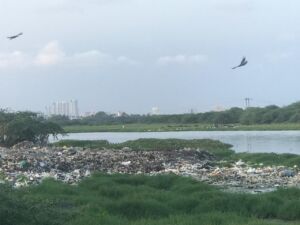


Our community generates approximately 80-100 tonnes of waste per month, and with our current community population rapidly growing, consumption patterns shifting, and keeping environmental protection at the forefront of our minds, we need to act NOW!
How do we find a solution to this overwhelming problem?
Thanks to the “2 Bins 1 Bag” concept-making news, we drew inspiration from pioneers’ relentless efforts to promote, create awareness, and make 3-way segregation a tangible solution. Segregation at the source was the only way forward.
What is the story behind this 2 Bins 1 Bag? It began as a small group initiative in the Indian state of Karnataka and grew into a movement, with the High Court in 2015 mandating that all waste generators in Bengaluru use the 2 Bins 1 Bag system.
You may ask why 2 Bins 1 Bag? Segregation at the source is simpler with colour codes, easier to educate housekeeping staff, domestic help, children, and residents, and eliminate plastic bags. The wet waste (biodegradable/organic) into green bins, reject waste into red bins, and all other dry waste (inorganic/mostly recyclable items) into white bags.
We needed to approach Waste Management holistically, with a well-defined sustainable and economically viable program and a long-term system for monitoring, evaluating, and tracking progress. Therefore, we collaborated with non-governmental organizations (NGOs) for recycling, an authorized garbage collection vendor, visited their collection yard, and reached out to other communities that already practiced 2 Bins 1 Bag segregation and other social groups.
We then met with Associations to present our plan and obtain their approval to work with the empanelled vendor. Once we had their support, we stepped up with consistent communication, guidelines, and awareness campaigns for residents, housekeeping staff, and domestic help. We kept track of and assessed progress throughout the implementation process.
Many people’s initial reaction was, “Why should I bother with segregation and recycling?” It’s no longer my problem once it’s left my house. Others can handle it.”
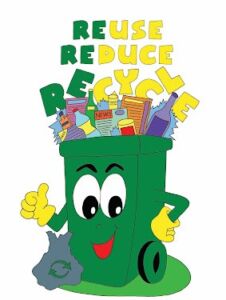
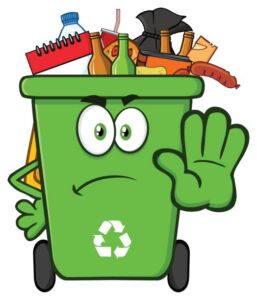
Perhaps they are unaware of the hazards of mixed waste, the waste cycle, the stakeholders involved, and the impact on public health and the environment. Few people have given up hope for positive change, believing that overburdened landfills and climate change are irreversible, among other things.
Waste management is both a commitment and a challenge!
Community awareness to change people’s attitudes toward waste, their role in waste management, guidance on how to practice and manage waste, and targeted interventions were all critical to encouraging residents to participate in the efforts.
A unified approach aids in better understanding the variety of factors influencing the various stages of Waste Management required for the entire system to function effectively. In addition to providing regular updates and information so that residents are aware of the community’s tangible benefits.
The challenges are numerous, and they fall not only on individuals but also on the community as a whole, NGOs, local Panchayats, and the government, who do not place enough emphasis on Waste Management. They are primarily concerned with cosmetic changes and the construction of additional landfills rather than with innovations in the waste disposal and recycling methods and the development of a solid infrastructure to achieve sustainable Waste Management.
Have we ever considered the social impact of these landfills or even been aware of the existence of informal sector workers who mostly live near these landfills and spend most of their working hours inside them? Who are they?
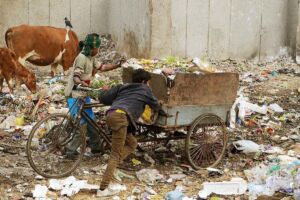
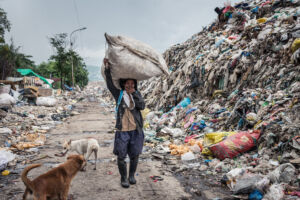 They are individuals and families of scavengers and rag pickers who make a living by collecting, sorting, and selling recyclable and reusable material from mixed waste that we throw into dumpsters, landfills, waste collection points, and other places. They are indispensable to the more extensive Waste Management system yet an invisible section of society that is left vulnerable to health hazards due to their scavenging activities, exploitation, and social stigma.
They are individuals and families of scavengers and rag pickers who make a living by collecting, sorting, and selling recyclable and reusable material from mixed waste that we throw into dumpsters, landfills, waste collection points, and other places. They are indispensable to the more extensive Waste Management system yet an invisible section of society that is left vulnerable to health hazards due to their scavenging activities, exploitation, and social stigma.
How can we integrate them into the formal Waste Management stream? First, the Government and NGOs should consider providing them with social and welfare benefits, including medical care and treatment. They must also provide them with protective gloves, masks, and shoes for waste collection.
Our empanelled Garbage Collection Vendor provides an alternate sustainable livelihood for 30+ of the Rag Picker families. They assist in sorting dry waste into 79 different categories and sell what they can to local recyclers directly. The remainder of the items is diverted to various recyclers.
We also collaborate with non-governmental organizations (NGOs) and individuals who collect recyclables. They sort them further and send them to organizations that recycle these items into usable products and donate them to the less fortunate, orphanages, old aged homes, and thrift stores.
What is the future of Waste Management?
We can only hope that our long-term sustainable practices will ensure that the current generation, particularly our children and youth, see waste as a resource opportunity and continue to implement best Waste Management practices for years to come.
Our children are already aware that specific actions have consequences. Therefore, it is necessary to instil a sense of responsibility in children by empowering them and encouraging them to be a part of the bigger picture.
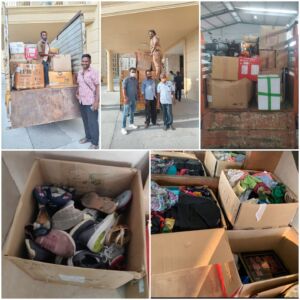
During our recycling campaigns, we have them create posters, organize recycling-related activities, quizzes, artwork projects with recyclable items, and scavenger hunts that involve searching for recyclable items or looking for hidden words to form a recycling slogan. It’s just a matter of making it exciting and capturing their attention.
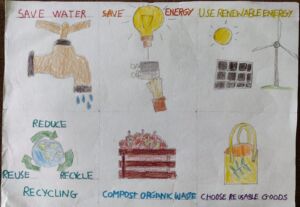
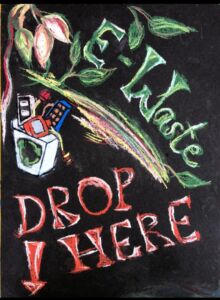
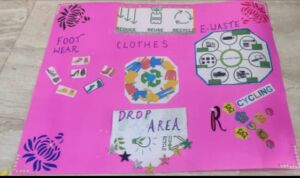
Our community has come a long way with the support of some associations, community residents, the Green Team represented by volunteers from these towers, and other resident volunteers who help out during the campaigns, drives, and activities.
Our goals for the future are to implement a more proactive engagement with all stakeholders, improve community understanding of waste issues, expand our reach to other communities and areas around our township, and support Waste Management campaigns and programs.
The golden rules of Waste Management are sustainable living by each individual, so we reduce the amount of waste to be treated, segregation at the source, proper Disposal, and Recycling.
Most of our trash “gets a second life,” while we don’t.
Hold this thought and trust the process of Waste Management!

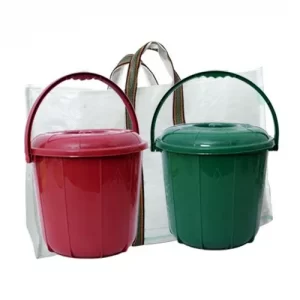
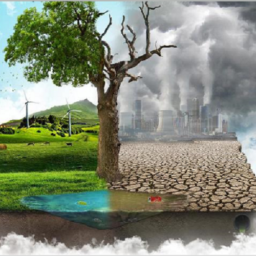
Our Green waste generated manure for plants and trees.
Organised groves have been done, having fruit – trees.
A true haven for both native and migratory avians.
Nice florals have been done around our play- park and school avenues.
All plastic, metal and paper cum board matters in packing materials which get released are duly accepted as re-use matter by local recyclers.
After the Green bin and the Blue have safely dealt with the waste, only earth matter is left, which is returned to soil.
In this pandemic time , we take a great care to safely deal with sanitary wastes that are duly incinerated in outside facility. We are fully satisfied, and our Team keeps improving the practices to evolve total sustainability and go on to achieve SDGs too.
We Salute and pay our Respects to one and all who have helped in this noble Green-venture in evolving resources from wastes.
Well wishes to All.
Thank you Ajit. Yes, the community is working towards sustainable waste management. Kudos to all!
I agree with you. These issues must start right away from our homes . Educate our generation in keeping our surroundings away from gathering waste stuff. In our factory which is a continuous processing industry we make a point of zero discharge to environment.
Yes! Segregation at the source is the only way forward. Thank you.